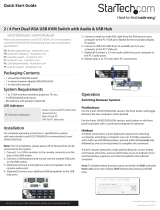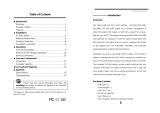
Instruction Manual
8
A triangle mark (
►
) to the right of a name indicates the port is cascaded to a Slave; the
number at the left of the triangle mark shows the number of ports the Slave has (i.e. 8 for
SV831DUSB). The <ENTER> key brings you one level down and another screen pops up
listing the names of the computers on that Slave. The name of the Slave will be shown
at the upper right corner of the OSD menu. It is useful to group computers and still be
able to see the group name.
An eye mark (
N
) to the right of a name indicates the computer is selected to be monitored
in Scan mode. In OSD, this mark can be switched on or o by function key <F2>.
Press the <ESCAPE> key to exit the OSD and to return to the selected computer, The
computer name is also shown on the screen.
Function key <F1>:
To edit the name entry of a computer or a Slave. First, use the <UP> and <DOWN> arrow
keys to highlight a channel then press <F1> followed by name entry. Valid characters are
‘A’~’Z’, ‘0’~’9’ and the dash character. Lowercase letters are converted to uppercase ones.
Press the <BACKSPACE> key to delete a letter one at a time. Non-volatile memory stores
all name entries until you change, even if the unit is powered down.
Function key <F2>:
To switch the eye mark (
N
) of a computer on or o. First, use the <UP> and <DOWN>
arrow keys to highlight it, then press <F2> to switch its eye mark on or o. If Scan
Type is ’Ready PC +
N
’, only the power-on and eye mark selected computers will be
displayed sequentially in Scan mode.
Function key <F3>:
To lock a device (a computer or a Slave) from unauthorized access, use Security.
Security is eective for only one device (a computer or a Slave). To lock a device,
use the <UP> and <DOWN> arrow keys to highlight it, then press <F3>. Now,
enter up to 4 characters (‘A’~’Z’, ‘0’~’9’, ‘-’) followed by <ENTER> as new password. A
Security enabled device is marked with a lock (Ï ) following its channel number. To
permanently disable the security function from a locked device, highlight it, press
<F3> then enter the password.
If you want to access the locked device temporarily, simply highlight it and press
<ENTER>, the OSD will ask you for the password. After entering the correct password,
you are allowed to use the device. This device is automatically re-locked once you
switch to another port. During Scan mode, OSD skips the security-enabled device.
NOTE: If you forget the password, the only way to permanently erase all of the
passwords is to: For SV831DUSB and SV1631DUSB, press and hold the 1 and 2
front panel buttons, then hold 7 and 8. Release 7 and 8, then release 1 and 2. For
SV431DUSB, press 3 and 4 instead of 7 and 8.























